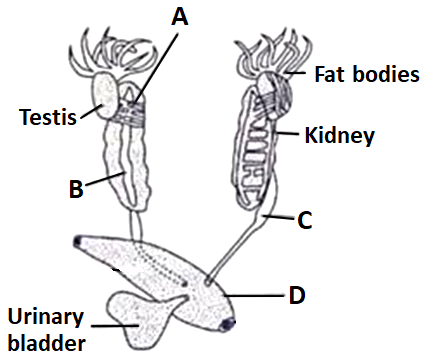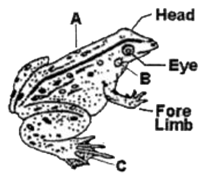Select Question Set:
In male frog, cloaca is used to pass out -
1. Faecal matter only
2. Urine only
3. Sperms only
4. Faeces, urine and sperm
Subtopic: Frogs: Anatomy (Digestive System) |
95%
Level 1: 80%+
Please attempt this question first.
Hints
Please attempt this question first.
Go through the following figure indicating the male reproductive system of frog. Identify A to D -


| A | B | C | D | |
| 1. | Bidder's canal | Adrenal gland | Urinogenital duct | Rectum |
| 2. | Bidder's canal | Adrenal gland | Urinogenital duct | Cloaca |
| 3. | Vasa efferentia | Adrenal gland | Urinogenital duct | Cloaca |
| 4. | Vasa efferentia | Thyroid gland | Urinogenital duct | Cloaca |
Subtopic: Frogs: Anatomy (Male Reproductive System) |
75%
Level 2: 60%+
Please attempt this question first.
Hints
Please attempt this question first.
For female frog, which of the following is false?
| I. | One pair ovaries is situated near kidneys |
| II. | Ovary has functional connection with kidney |
| III. | Convoluted, tubular, ciliated and glandular oviduct arises from ovary and opens into cloaca |
| IV. | Oviduct and ureter open separately into the cloaca |
| V. | A female frog can lay 2500-3000 ova at a time |
| 1. | I and II | 2. | only II |
| 3. | I and IV | 4. | IV and V |
Subtopic: Frogs: Anatomy (Female Reproductive System) |
70%
Level 2: 60%+
Please attempt this question first.
Hints
Please attempt this question first.
Which of the following is false?
1. Fertilization is external (in water) in frog
2. In frog, development involves larval stage called tadpole
3. Tadpole undergo metamorphosis to form the adult
4. Development in frog is direct
1. Fertilization is external (in water) in frog
2. In frog, development involves larval stage called tadpole
3. Tadpole undergo metamorphosis to form the adult
4. Development in frog is direct
Subtopic: Frogs: Anatomy (Female Reproductive System) |
95%
Level 1: 80%+
Please attempt this question first.
Hints
Please attempt this question first.
Identify A, B and C respectively -

1. Trunk, Tympanum, Web
2. Neck, Brown eye spot, Web
3. Trunk, Tympanum, Hind limb
4. Neck, Tympanum, Hindlimb

1. Trunk, Tympanum, Web
2. Neck, Brown eye spot, Web
3. Trunk, Tympanum, Hind limb
4. Neck, Tympanum, Hindlimb
Subtopic: Frogs: Morphology |
52%
Level 3: 35%-60%
Please attempt this question first.
Hints
Please attempt this question first.
The skin of frog:
1. Is smooth and slippery due to the presence of mucus
2. In the dorsal side is usually pale yellow
3. In the ventral side is usually olive green with dark irregular spots
4. Is related to all the above statements
1. Is smooth and slippery due to the presence of mucus
2. In the dorsal side is usually pale yellow
3. In the ventral side is usually olive green with dark irregular spots
4. Is related to all the above statements
Subtopic: Frogs: Morphology |
83%
Level 1: 80%+
Please attempt this question first.
Hints
Please attempt this question first.
Eyes of frogs:
1. Are bulged and lacks nictitating membrane
2. Posses nictitating membrane that protects them while in water
3. Provide them with 180° vision
4. Are compound eyes
1. Are bulged and lacks nictitating membrane
2. Posses nictitating membrane that protects them while in water
3. Provide them with 180° vision
4. Are compound eyes
Subtopic: Frogs: Morphology |
90%
Level 1: 80%+
Please attempt this question first.
Hints
Please attempt this question first.
Frogs:
1. Exhibit sexual dimorphism
2. Have hindlimbs and forelimbs which help in walking, leaping and burrowing
3. Have webbed digits that help in swimming
4. Show all of the above features
1. Exhibit sexual dimorphism
2. Have hindlimbs and forelimbs which help in walking, leaping and burrowing
3. Have webbed digits that help in swimming
4. Show all of the above features
Subtopic: Frogs: Morphology |
90%
Level 1: 80%+
Please attempt this question first.
Hints
Please attempt this question first.
Read the following statements for frog and answer accordingly:
A. Duodenum receives bile and pancreatic juice through hepatopancreatic duct
B. Salivary glands are absent in frog, so digestion starts in stomach
1. Both the statements A and B are correct and B is the correct explanation of A
2. Both the statements A and B are correct but B is not the correct explanation of A
3. Statement A is correct but B is incorrect
4. Both the statements A and B are incorrect
A. Duodenum receives bile and pancreatic juice through hepatopancreatic duct
B. Salivary glands are absent in frog, so digestion starts in stomach
1. Both the statements A and B are correct and B is the correct explanation of A
2. Both the statements A and B are correct but B is not the correct explanation of A
3. Statement A is correct but B is incorrect
4. Both the statements A and B are incorrect
Subtopic: Frogs: Anatomy (Digestive System) |
68%
Level 2: 60%+
Please attempt this question first.
Hints
Please attempt this question first.
In frogs:
1. Digestion of food takes place by the action of HCl and gastric juices secreted from the walls of stomach
2. Partially digested food called chyme is passed from stomach to the first part of intestine, the ileum
3. Digested food is absorbed by the numerous finger-like folds in the inner wall of intestine called villi and microvilli
4. Both (1) and (3) are correct
1. Digestion of food takes place by the action of HCl and gastric juices secreted from the walls of stomach
2. Partially digested food called chyme is passed from stomach to the first part of intestine, the ileum
3. Digested food is absorbed by the numerous finger-like folds in the inner wall of intestine called villi and microvilli
4. Both (1) and (3) are correct
Subtopic: Frogs: Anatomy (Digestive System) |
92%
Level 1: 80%+
Please attempt this question first.
Hints
Please attempt this question first.
Select Question Set:






